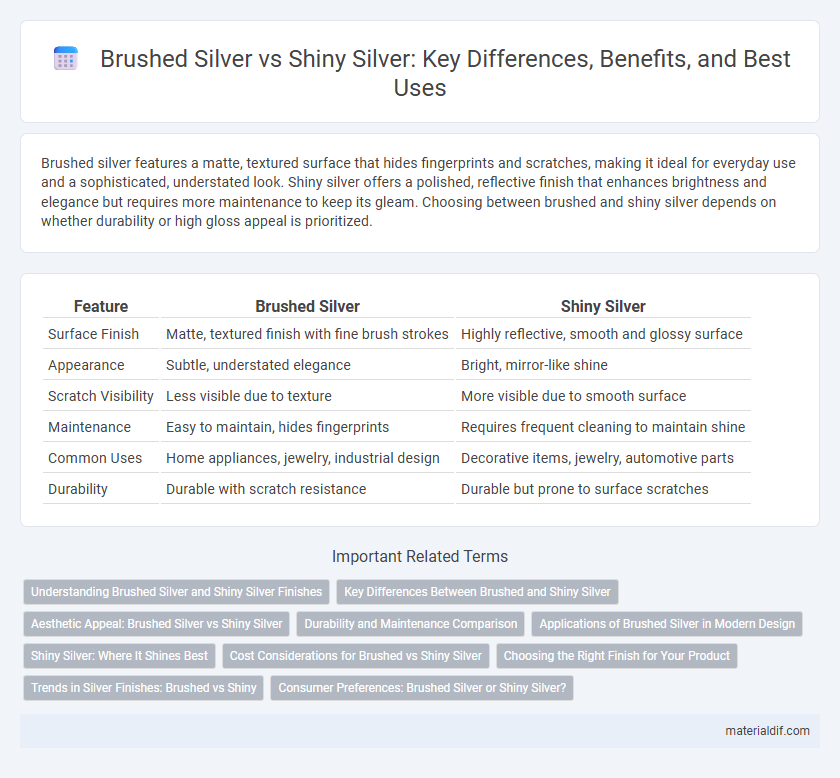Brushed silver features a matte, textured surface that hides fingerprints and scratches, making it ideal for everyday use and a sophisticated, understated look. Shiny silver offers a polished, reflective finish that enhances brightness and elegance but requires more maintenance to keep its gleam. Choosing between brushed and shiny silver depends on whether durability or high gloss appeal is prioritized.
Table of Comparison
| Feature | Brushed Silver | Shiny Silver |
|---|---|---|
| Surface Finish | Matte, textured finish with fine brush strokes | Highly reflective, smooth and glossy surface |
| Appearance | Subtle, understated elegance | Bright, mirror-like shine |
| Scratch Visibility | Less visible due to texture | More visible due to smooth surface |
| Maintenance | Easy to maintain, hides fingerprints | Requires frequent cleaning to maintain shine |
| Common Uses | Home appliances, jewelry, industrial design | Decorative items, jewelry, automotive parts |
| Durability | Durable with scratch resistance | Durable but prone to surface scratches |
Understanding Brushed Silver and Shiny Silver Finishes
Brushed silver features a matte texture achieved through a fine abrasion process, creating a subtle, non-reflective surface that resists fingerprints and scratches. Shiny silver has a polished, mirror-like finish that enhances its reflective properties, offering a bright and glossy appearance ideal for decorative items. Choosing between brushed and shiny silver depends on the desired aesthetic and functionality, with brushed silver favored for understated elegance and durability, while shiny silver suits classical, high-gloss designs.
Key Differences Between Brushed and Shiny Silver
Brushed silver features a matte finish with fine, linear scratches that reduce glare and hide fingerprints, making it ideal for everyday use and a subtle aesthetic. Shiny silver has a polished, reflective surface that enhances brightness and elegance, often preferred for jewelry and decorative pieces where visual impact is important. The key difference lies in texture and appearance: brushed silver offers a muted, durable look while shiny silver provides high gloss and mirror-like shine.
Aesthetic Appeal: Brushed Silver vs Shiny Silver
Brushed silver features a matte, textured finish that diffuses light, offering a subtle and sophisticated aesthetic ideal for modern and industrial designs. Shiny silver boasts a reflective, polished surface that enhances brightness and adds a striking, luxurious appeal suitable for contemporary and classic styles. The choice between brushed and shiny silver ultimately depends on the desired visual impact and the ambiance of the space or product.
Durability and Maintenance Comparison
Brushed silver features a matte finish that effectively conceals fingerprints and minor scratches, enhancing its durability and reducing the need for frequent maintenance. In contrast, shiny silver's reflective surface is prone to visible smudges and scratches, requiring regular polishing to maintain its luster. Both finishes offer corrosion resistance typical of silver, but brushed silver demands less upkeep in high-traffic or frequently handled applications.
Applications of Brushed Silver in Modern Design
Brushed silver is widely utilized in modern design for its subtle texture and matte finish, offering a sophisticated alternative to the reflective surface of shiny silver. Popular applications include kitchen appliances, architectural hardware, and electronic devices, where brushed silver resists fingerprints and smudges while providing a contemporary aesthetic. Its durability and understated elegance make brushed silver ideal for interior design elements like lighting fixtures and furniture accents.
Shiny Silver: Where It Shines Best
Shiny silver excels in modern interior design, reflecting light to create a bright, sophisticated ambiance ideal for kitchens and living rooms. Its high-gloss finish enhances decorative items, jewelry, and tech gadgets by highlighting intricate details and providing a sleek, polished appearance. Compared to brushed silver, shiny silver offers superior luminosity and elegance, making it the preferred choice for upscale accessories and statement pieces.
Cost Considerations for Brushed vs Shiny Silver
Brushed silver typically incurs lower production costs due to its matte finish requiring less intensive polishing compared to shiny silver, which demands more labor and energy for a high-gloss, reflective surface. The durability of brushed silver also reduces long-term maintenance expenses, making it more cost-effective for certain applications such as jewelry and home decor. Shiny silver often involves higher prices both in initial purchase and upkeep, driven by its susceptibility to tarnishing and need for frequent cleaning.
Choosing the Right Finish for Your Product
Brushed silver features a matte texture with fine, linear strokes that reduce glare and fingerprints, making it ideal for products requiring a subtle and sophisticated appearance. Shiny silver offers a highly reflective, polished surface that enhances visual impact and highlights design details, suitable for luxury or decorative items. Selecting between brushed and shiny silver depends on the desired aesthetic, maintenance considerations, and the product's functional environment.
Trends in Silver Finishes: Brushed vs Shiny
Brushed silver finishes offer a matte, textured appearance that reduces glare and fingerprints, making them increasingly popular in modern interior design and jewelry trends. Shiny silver boasts a highly reflective, polished surface that emphasizes elegance and luxury, often favored in classic and formal settings. Current market analysis shows a rising preference for brushed silver in contemporary applications, balancing aesthetics with practicality.
Consumer Preferences: Brushed Silver or Shiny Silver?
Consumer preferences often favor brushed silver for its subtle, matte finish that effectively conceals fingerprints and scratches, making it ideal for everyday use in home decor and electronics. Shiny silver appeals to those seeking a polished, eye-catching appearance with a highly reflective surface, commonly preferred in jewelry and luxury items. The choice between brushed silver and shiny silver ultimately depends on whether durability and understated elegance or vibrant and glossy aesthetics are prioritized.
Brushed Silver vs Shiny Silver Infographic

 materialdif.com
materialdif.com